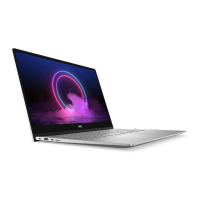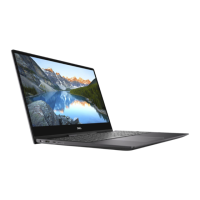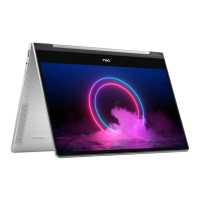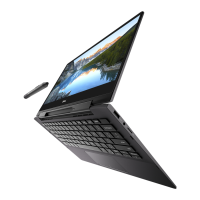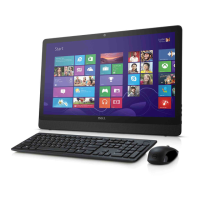Do you have a question about the Dell Inspiron 2350 and is the answer not in the manual?
Provides essential safety guidelines to protect your computer and ensure personal safety during operation and maintenance.
Lists necessary tools for performing manual procedures, ensuring proper equipment is available.
Steps to follow after completing internal work to ensure the computer is reassembled correctly and safely.
Detailed steps for reinstalling a memory module into the computer, ensuring proper connection and seating.
Procedure for safely detaching the computer's base cover to access internal components for maintenance.
Steps to detach the main computer base from the stand assembly for further component access.
Instructions for safely removing the hard drive assembly from the computer base.
Steps for reinstalling the system board, including connecting cables and securing it to the computer base.
Procedure to enter the system's Service Tag into the BIOS after replacing the system board.
Instructions on how to access and navigate the computer's system setup utility.
Overview of the different areas and information displayed within the system setup interface.
Details various configuration options available within the system setup, categorized by function.
Procedure to clear forgotten BIOS passwords by accessing specific internal components.
Steps to reset CMOS settings to default, typically by removing the coin-cell battery.
| Memory slots | 2 |
|---|---|
| Internal memory | 16 GB |
| Memory slots type | SO-DIMM |
| Memory clock speed | 1600 MHz |
| Memory form factor | DIMM/SO-DIMM |
| Internal memory type | DDR3-SDRAM |
| Memory layout (slots x size) | 2 x 8 GB |
| HDD speed | 5400 RPM |
| SSD capacity | 32 GB |
| HDD interface | SATA II |
| Storage media | HDD+SSD |
| Optical drive type | No |
| Card reader integrated | Yes |
| Total storage capacity | 1000 GB |
| Compatible memory cards | SD, SDXC, SDHC, MMC, Memory Stick (MS), MS PRO, MSXC, MS Pro-HG |
| Number of storage drives installed | 1 |
| Pixel pitch | 0.2652 x 0.2652 mm |
| Screen shape | Flat |
| Display diagonal | 23 \ |
| Tilt angle range | -5 - 90 ° |
| Touch technology | Multi-touch |
| Native aspect ratio | 16:9 |
| AC adapter output current | 2.5 A |
| On-board graphics card ID | 0x416 |
| Discrete graphics card model | AMD Radeon HD 8690A |
| On-board graphics card model | Intel® HD Graphics 4600 |
| Discrete graphics card memory | 2 GB |
| Discrete graphics memory type | GDDR5 |
| On-board graphics card family | Intel® HD Graphics |
| Maximum on-board graphics card memory | 1.74 GB |
| On-board graphics card base frequency | 400 MHz |
| On-board graphics card DirectX version | 11.2/12 |
| On-board graphics card dynamic frequency (max) | 1150 MHz |
| Number of displays supported (on-board graphics) | 3 |
| Total megapixels | 2 MP |
| Audio system | Waves MaxxAudio 4 |
| RMS rated power | 8 W |
| Wi-Fi standards | 802.11b, 802.11g, Wi-Fi 4 (802.11n) |
| Bluetooth version | 4.0 |
| Ethernet LAN data rates | 10, 100, 1000 Mbit/s |
| USB 2.0 ports quantity | USB 2.0 ports have a data transmission speed of 480 Mbps, and are backwards compatible with USB 1.1 ports. You can connect all kinds of peripheral devices to them. |
| eSATA/USB 2.0 ports quantity | 0 |
| USB 3.2 Gen 1 (3.1 Gen 1) Type-A ports quantity | 4 |
| Product color | Black, Silver |
| Product type | All-in-One PC |
| Motherboard chipset | Intel® HM87 |
| Operating system installed | Windows 8.1 |
| Operating system architecture | 64-bit |
| AC adapter power | 180 W |
| AC adapter frequency | 50/60 Hz |
| AC adapter input voltage | 100 - 240 V |
| AC adapter output voltage | 19.5 V |
| Storage temperature (T-T) | -40 - 65 °C |
| Operating temperature (T-T) | 5 - 35 °C |
| Storage relative humidity (H-H) | 10 - 95 % |
| Operating relative humidity (H-H) | 10 - 90 % |
| Sustainability certificates | ENERGY STAR |
| Bus type | DMI |
| Stepping | C0 |
| Tjunction | 100 °C |
| Processor code | SR1PQ |
| Processor cache | 6 MB |
| Processor model | i7-4710MQ |
| System bus rate | 5 GT/s |
| Processor family | Intel® Core™ i7 |
| Processor series | Intel Core i7-4700 Mobile series |
| Processor socket | PGA946 |
| Processor threads | 8 |
| Processor codename | Haswell |
| Processor frequency | 2.5 GHz |
| Processor cache type | Smart Cache |
| Processor lithography | 22 nm |
| Processor manufacturer | Intel |
| Processor front side bus | - MHz |
| PCI Express slots version | 3.0 |
| Processor boost frequency | 3.5 GHz |
| PCI Express configurations | 1x16, 2x8, 1x8+2x4 |
| Thermal Design Power (TDP) | 47 W |
| Maximum number of PCI Express lanes | 16 |
| Memory types supported by processor | DDR3L-SDRAM |
| Memory channels supported by processor | Dual |
| Memory clock speeds supported by processor | 1333, 1600 MHz |
| Memory bandwidth supported by processor (max) | 25.6 GB/s |
| Processor ARK ID | 78931 |
| Intel TSX-NI version | 0.00 |
| Processor package size | 37.5 x 32 x 1.6 mm |
| Supported instruction sets | AVX 2.0, SSE4.1, SSE4.2 |
| Intel Identity Protection Technology version | 1.00 |
| Depth (with stand) | 241 mm |
|---|---|
| Width (with stand) | 569 mm |
| Height (with stand) | 418.86 mm |
| Weight (with stand) | 8630 g |
| Depth (without stand) | 26.5 mm |
| Height (without stand) | 347.62 mm |
| Weight (without stand) | 7250 g |




